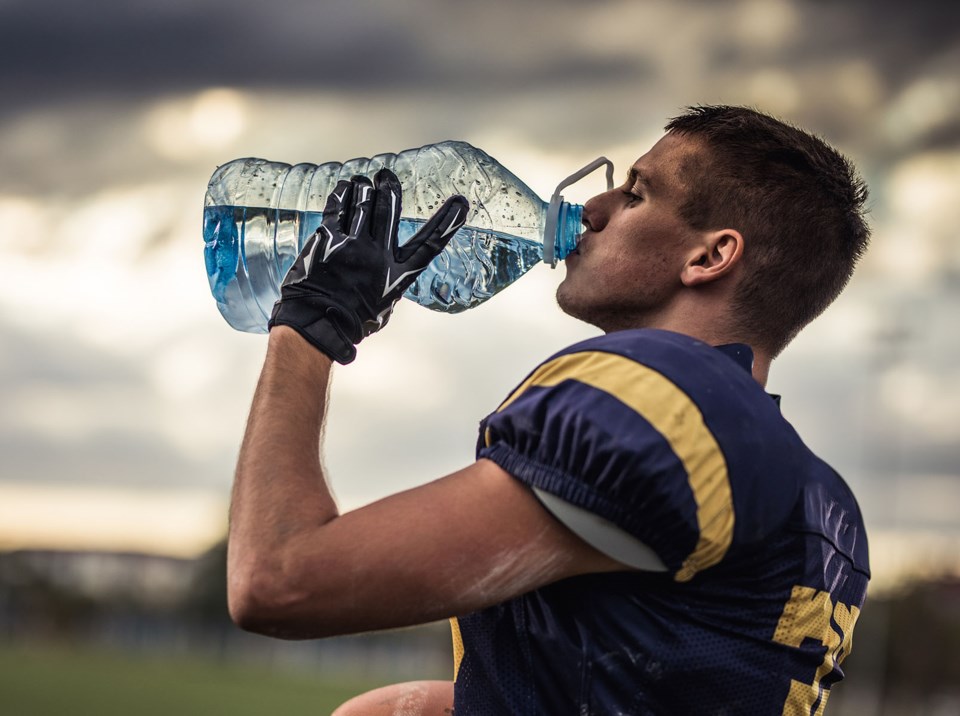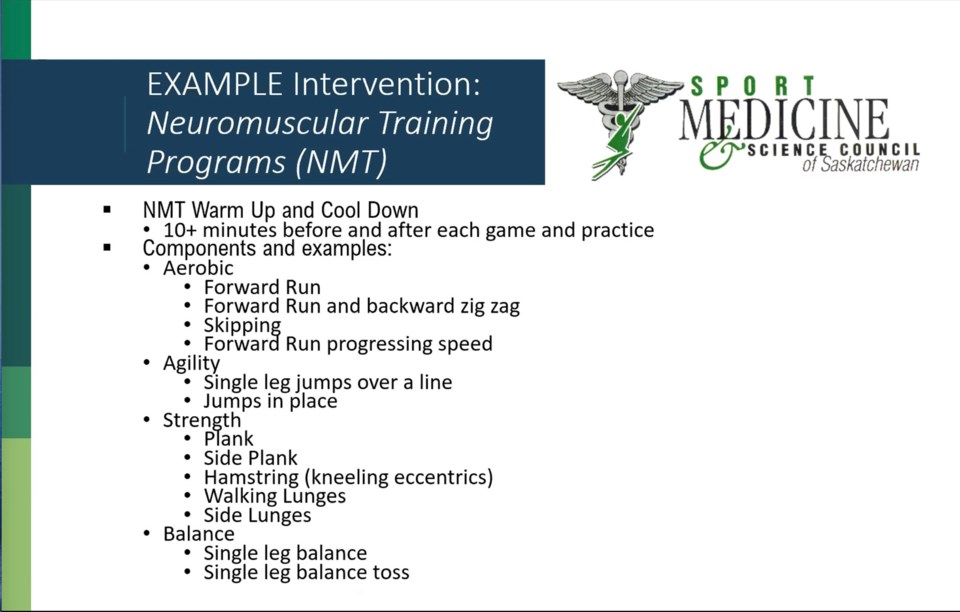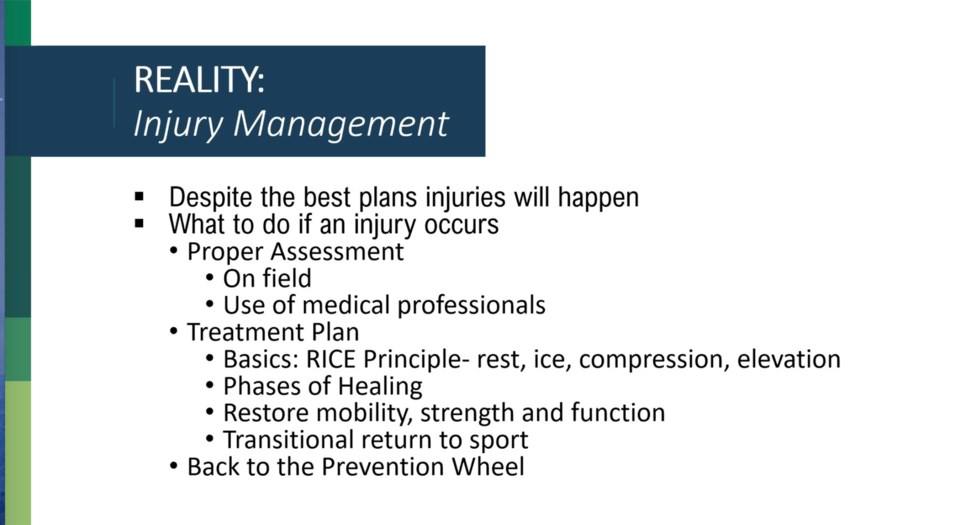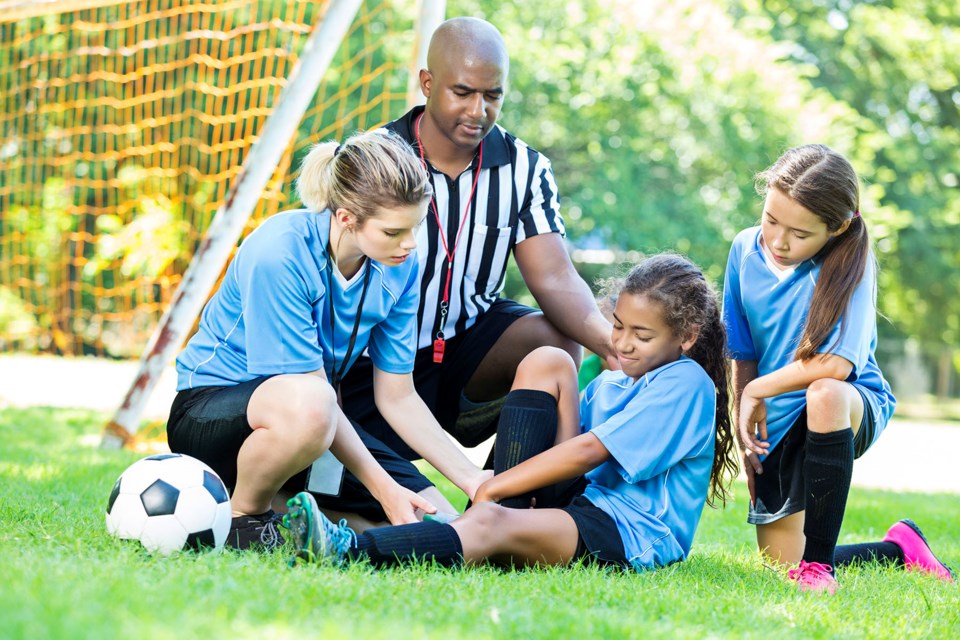You play hard enough and competitively enough, things are going to happen. Bumps and tweaks, pulls and strains, everything one can imagine while taking part in a stressful activity.
The good thing is there are plenty of ways to mitigate the damage -- and it all starts with the most basic of knowledge, growing into a full suite of information and preventatives that modern athletics have honed over the years.
With that in mind, Saskatchewan’s Culture, Recreation and Sports Districts are holding a series of Zoom meetings as part of a sports injury prevention campaign designed to help keep athletes of all ages safe when it comes to playing the sports games they love.
The first such event was hosted by the Rivers West District for Culture, Recreation and Sport on Wednesday afternoon and featured certified athletic therapist Lisa Swallow of the Sport Medicine Science Council of Saskatchewan offering a basic rundown of some of the things to look for when it comes to avoiding and managing injuries.
“Injury prevention begins with the concept of risk management,” Swallow began. “We want to identify what might pose an issue or a problem within a sport or an activity that could lead to injury, and if we can predict the future a little bit about what could happen, we could potentially apply an intervention to help not going down the road of potential injury.”
Swallow’s program included a model of injury management that follows a wheel format of knowing injuries, finding the risk factors and causes, using intervention and planning to prevent injuries and then evaluate the effectiveness of that intervention.
Knowing the Injuries and How They Happen
It all starts with the damage itself, with cheerleading given as an example where knee and ankle injuries are common, or pickleball, where knee injuries and smaller aches and pains are often found, along with shoulder strains, tennis elbow and other common ailments.
“If we know the injury or what we expect can potentially happen based on past experience or previous things we’ve seen or research that has been done on the sport, that’s where we can brainstorm a little bit about a prevention strategy,” Swallow said.
Dealing with chronic and acute injuries is also a factor and can play into how damage occurs. This is especially common when it comes to chronic injuries, where issues can gradually set in.
“It’s that more long-term gradual thing that just doesn’t seem to go away,” Swallow explained. “They often occur due to a lack of recovery, so we have a situation where a series of micro-traumas occur over time, which leads to an inflammatory response and symptoms.”
Acute injuries are the instant damage -- fractures and dislocations, ligament and tendon ruptures, the issues that see players helped off the field. Those can become chronic over time if not looked after, so dealing with acute injuries properly and quickly can become a preventative in the future.
Risk Factors
Risk factors come in five categories in Swallow’s model: sport specific, venue and environmental, athlete specific, coaching specific, mechanisms of injury.
Sport specific is obvious, beginning with whether or not the sport is contact or non-contact.
“That’s going to affect what type of injuries you face, as well as the specific rules you might face,” Swallow said. “In something like soccer, there’s going to be contact between players, and the implement of the ball can be problematic too,” with concussions as one concern.
Environmental risks involve field and court conditions and hot and cold environments, as well as where fans are located.
Athlete specific involves knowing the athlete, considering their age, potential overtraining and the level of competition. That’s before taking previous medical history into account, as well as prior injuries.
“You have to look at if they’re doing too much, too soon or too heavy for their ability, or an undertraining component where they don’t have the physical capacity for the sport,” Swallow said. “And if there have been prior injuries, what has the rehab process been for that? How should they moving specific to their age and ability and how do we improve those movement patterns? Then things like nutrition and hydration and rest, things that are very specific to the athlete.”
Coaching specific involves knowing the athlete and when they can progress within the sport safely.
“You’re designing a program and planning out a season, how are you going to plan that so you peak in your competition time, how do you balance all of those? They all play roles in mitigating risk of injury,” Swallow said.
Finally, the mechanism of injury looks at a contact or non-contact sport and if the sport is one where there will be an acute injury or more chronic, repetitive strain injuries. Knowing what potential injuries are before they happen can help with prevention.
 Getty Images
Getty ImagesDeveloping and Choosing an Intervention
This involves the same five categories as risk factors, but deals with direct intervention to prevent injuries.
Swallow used football as an example, where a situation occurs where too many ACL tear knee injuries are happening. That might come down to an equipment issue such as cleat use, where the cleats need to have a shorter length because the foot can’t give way in the grass or turf.
“So we’d look at specific equipment in the sport, what range of motion and strength requirements are required to participate safely and effectively?” Swallow said. “It comes down to rules and equipment and do we have those things in place to mitigate injury.”
Venue and environment specific covers everything from lighting, field conditions and temperature, making sure all aspects are safe for athletes.
Swallow pointed to a Football Canada Cup contest she worked in New Brunswick where the temperature was around 50 C at field level.
“So you have to look out for heat exhaustion and heat stroke in that case,” Swallow said. “The tournament had a rule in place where there were more water breaks, a longer halftime and longer break between quarters, as well as a water break any time a player needed it. So there are things you do that can address those specific things that can cause risk factors.”
Athlete specific prevention involves first and foremost proper training and proper skill development, as well as specific rules designed to keep athletes safe, as well as making sure athletes have the strength to participate in the sport.
Coach specific deals with proper warm-up and cool-down and other information, much of which is gained through coaching programs designed not only to teach about the sport, but how to properly prepare.
That includes neuromuscular training, which involves a program of good-quality movements designed for athletes to get properly warmed up for their sport. In the past, that meant a jog around the court and some static stretching. Now, it’s a dynamic program filled with movements to prepare the whole body for strenuous activity -- featuring aerobic, agility, strength and balance components.
“When athletes use this as a warm-up and cool-down component, the research shows athletes are less-likely to be injured,” Swallow said. “That’s concerning both acute and chronic injuries when it comes to sports.”

Evaluate Effectiveness
This involves tracking injuries and following how recovery is going, and hopefully seeing improvement in injury avoidance in the future.
“There are probably 500 other things that could help us evaluate effectiveness and in each sport it’s going to be different,” Swallow said. “You want to have some means to evaluate what you’re doing so you know it’s having a positive benefit.”
Injuries Happen
“Despite the best plans, injuries are going to happen and when they do, you want to move past primary prevention and into secondary and tertiary prevention, which is just dealing with what’s happening,” Swallow said.
That involves dealing with the damage immediately on the field after it happens, working with medical professionals to help recover and following the basics of the treatment plan, including RICE -- rest, ice, compression and elevation.

“Then once that injury has recovered, then you’re looking back at the start of the wheel,” Swallow explained. ”What were the risk factors involved, is there something we can impact to change that and can that help… getting back into that primary prevention and mitigating some of this as you can rather than being more reactive to it after the fact.”
All in all, it’s an evolving process with the wheel always spinning around.
“If you’re thinking of things from that perspective, hopefully that’ll bring you into a space where you can have safe participation,” Swallow said.




